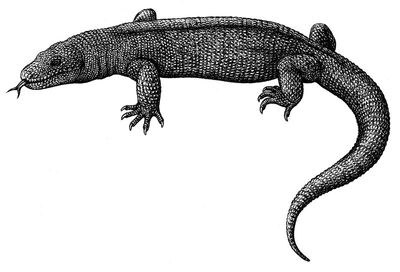Tag: sourceedit |
Tag: sourceedit |
||
| Line 14: | Line 14: | ||
tumblr_nw6rzi0yP31uujqb8o1_1280.jpg|Saurian Palaeosaniwa |
tumblr_nw6rzi0yP31uujqb8o1_1280.jpg|Saurian Palaeosaniwa |
||
</gallery> |
</gallery> |
||
| + | |||
| + | ==Gallery== |
||
| + | [[Palaeosaniwa/Gallery]] |
||
== References == |
== References == |
||
Revision as of 18:11, 6 June 2017

Palaeosaniwa is a basal varanoid lizard from late Cretaceous North America, specifically the Hell Creek Formation. A member of the Platynota, it is related to modern monitor lizards (the Varanidae) and the Gila monsters (Helodermatidae) alike.
Description
Palaeosaniwa was roughly comparable to a large monitor lizard (Varanidae) in size. Measuring perhaps five or six feet in length, it is the largest terrestrial lizard known from the Mesozoic period. It is similar to modern varanid lizards (particularly the Komodo dragon) in having bladelike teeth with minute serrations. These teeth would have been effective for seizing and cutting large prey items, and suggest that Palaeosaniwa fed on other vertebrates. Adult Palaeosaniwa would have been large enough to prey on any of the birds or mammals known from the time, small dinosaurs, and the eggs and juveniles of large dinosaurs.
Distribution
Palaeosaniwa was originally described from the late Campanian of Alberta. More recently it has been reported from the late Campanian of Montana, and the late Maastrichtian of Montana and Wyoming. It is known primarily from isolated teeth and vertebrae, but two partial skeletons have also been discovered. The type species, P. canadensis, is from Alberta. Although the Maastrichtian Palaeosaniwa has traditionally been referred to this species, it succeeds it by roughly ten million years. Given the distance in time between these animals, they are likely to represent distinct species, but the available fossils are too incomplete to be certain.
Relationships
Palaeosaniwa is a member of the Platynota, a group that includes the monitor lizards (Varanidae) and Gila monsters (Helodermatidae). Originally, it was thought to be a member of the Varanidae, but has also been interpreted as a relative of the Helodermatidae.[1] The most recent analysis places Palaeosaniwa outside of either Varanidae or Helodermatidae, as a stem member of the Varanoidea. Its precise affinities remain poorly understood, but it may be related to other Late Cretaceous, North American carnivorous lizards such as Parasaniwa, Paraderma, Labrodioctes, and Cemeterius.
In popular culture
- A Palaeosaniwa appeared in Giant Screen Films Waking the T. Rex: The Story of SUE Where it was trying to eat one of the T-Rex eggs including Sue. But Sue's Mother returned to the nest in time & she scared that egg eating lizard away.
- Palaeosaniwa will appear in the upcoming game, Saurian.
Gallery
Palaeosaniwa/Gallery
